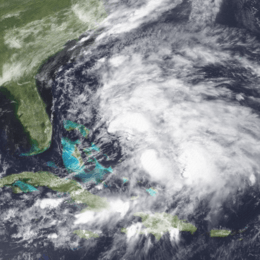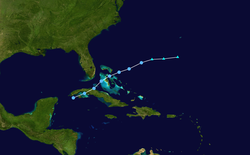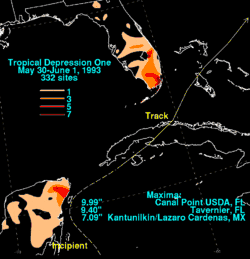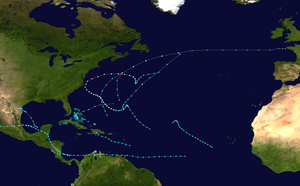Tropical Depression One (1993)
Tropical Depression One was a weak tropical cyclone that struck Cuba and the Bahamas in May and June 1993. It formed in the western Caribbean Sea on May 31 and produced heavy rainfall along its path. In Cuba, the precipitation reached 12.4 inches (31.5 cm), which caused widespread flooding and damage in nine provinces. Over 16,500 houses were damaged, and a further 1,860 were destroyed. At least seven people were killed in the country. In neighboring Haiti, the flooding killed thirteen people, as well as thousands of livestock. Rainfall was also reported in southern Florida, which eased drought conditions. The depression eventually crossed the Bahamas and became extratropical.
| Tropical depression (SSHWS/NWS) | |
 Tropical Depression One northeast of the Bahamas on June 1 | |
| Formed | May 31, 1993 |
|---|---|
| Dissipated | June 2, 1993 |
| Highest winds | 1-minute sustained: 35 mph (55 km/h) |
| Lowest pressure | 999 mbar (hPa); 29.5 inHg |
| Fatalities | 20 total |
| Areas affected | Cuba, Jamaica, Haiti, Florida, Bahamas |
| Part of the 1993 Atlantic hurricane season | |
Meteorological history

The origins of the tropical depression were from a tropical wave that exited the coast of Africa on May 13. It crossed the Atlantic Ocean and Caribbean Sea, reaching a position east of the Yucatan Peninsula by May 25. The system interacted with a monsoon-type circulation over Central America, and a broad low-level circulation developed near Cozumel, Mexico. Atmospheric pressure in the region fell gradually as the system organized, and on May 31, the National Hurricane Center classified it as Tropical Depression One near the Isle of Youth.[1] At the time of being upgraded, the circulation was located on the northwest side of the convection due to wind shear.[2]
Throughout its duration, the depression maintained a northeast track, due to an approaching shortwave trough to its north.[1] Late on May 31, the poorly organized center crossed western Cuba, accompanied by heavy rainfall but light winds.[3] By the time the circulation reached the Florida Straits, it was exposed and removed from the convection, although slight intensification was anticipated.[4] The depression accelerated northeastward through the Bahamas, passing near Nassau. Based on Hurricane Hunters observations, it maintained stronger winds in squalls away from the center, and the pressure deepened to 999 mbar (hPa; 29.5 inHg).[1] By June 2, reconnaissance flights into the system had difficulty discerning a circulation.[5] Later that day, the National Hurricane Center discontinued advisories, as the depression had become extratropical.[6] It strengthened slightly to reach gale-force winds as an extratropical storm, and persisted until early on June 3.[1]
Preparations and impact

In its first advisory on the depression, the National Hurricane Center emphasized the threat for heavy rainfall in Jamaica, Cuba, Haiti, south Florida, and the Bahamas. The agency also advised small craft in Cuba and the Cayman Islands to remain at port.[7] The depression was the first tropical cyclone threat to south Florida since Hurricane Andrew nine months prior, although officials noted the depression's winds were no cause for concern.[8]
The precursor to the disturbance brought locally heavy rainfall to the Yucatán Peninsula, with a maximum of 7.09 inches (18 cm) in Lázaro Cárdenas, Quintana Roo.[9] The depression produced intense precipitation across central and eastern Cuba, peaking at 12.4 inches (31.5 cm) in Topes de Collantes.[1] In Victoria de Las Tunas, a rainfall total of 8.6 inches (21.8 cm) set the new record most rainfall in 24 hours. The rainfall caused flooding of rivers and lakes behind dams, and in some places, residents required rescue from the roofs of their houses.[10] Officials forced the evacuation of 40,000 people in several provinces, and across the country, the storm destroyed 1,860 homes and damaged 16,500 more.[11] The flooding blocked mountainous highways in Santiago de Cuba Province, and in Las Tunas Province railway lines were damaged.[10] Widespread crop damage occurred just two months after the Storm of the Century left similar heavy damage. The flooding damaged 87 sugar production centers.[11] The depression killed seven people in the country with another five missing, as reported by a newspaper on the day after the depression left the island.[10] After the storm passed, the Cuban government activated the Civil Defense, while National Relief Services worked to rescue all people affected by the flooding.[11]
Elsewhere along its path, heavy rainfall was reported in Jamaica, Hispaniola, and southern Florida.[1] In Haiti, the rainfall caused 13 deaths and left thousands of livestock killed.[12] In Florida, the precipitation peaked at 9.99 inches (25.4 cm) in Canal Point near Lake Okeechobee.[9] Another high total was 9.4 inches (23.9 cm) in Tavernier,[1] and the precipitation as a whole alleviated drought conditions.[13]
References
- Lixion Avila (1993). "Tropical Depression One Preliminary Report". National Hurricane Center. Retrieved 2010-03-03.
- Max Mayfield (1993). "Discussion One". National Hurricane Center. Retrieved 2010-03-03.
- Max Mayfield (1993). "Discussion Two". National Hurricane Center. Retrieved 2010-03-03.
- Lixion Avila (1993). "Discussion Three". National Hurricane Center. Retrieved 2010-03-03.
- Richard Pasch (1993). "Discussion Seven". National Hurricane Center. Retrieved 2010-03-03.
- Miles Lawrence (1993). "Discussion Nine". National Hurricane Center. Retrieved 2010-03-03.
- Max Mayfield (1993). "Public Advisory One". National Hurricane Center. Retrieved 2010-03-03.
- Associated Press (1993). "Season's First Tropical Depression Forms". Retrieved 2010-03-03.
- David M. Roth (2010-04-06). "Tropical Depression One – May 30 – June 1, 1993". Hydrometeorological Prediction Center. Retrieved 2010-04-07.
- Mimi Whitefield (1993). "Heavy Rains Drench Cuba Leaving 7 Dead". Miami Herald. Retrieved 2010-03-03.
- United Nations Department of Humanitarian Affairs (DHA) (1993). "Cuba — Floods Jun 1993 UN DHA Information Report No. 1". Archived from the original on 2011-07-07. Retrieved 2010-03-04.
- Milwaukee Journal (1993). "Hurricane Season". Retrieved 2010-03-03.
- Sarasota Herald-Tribune (1993). "Tropical depression forms; South Florida gets soaked". Retrieved 2010-03-03.
